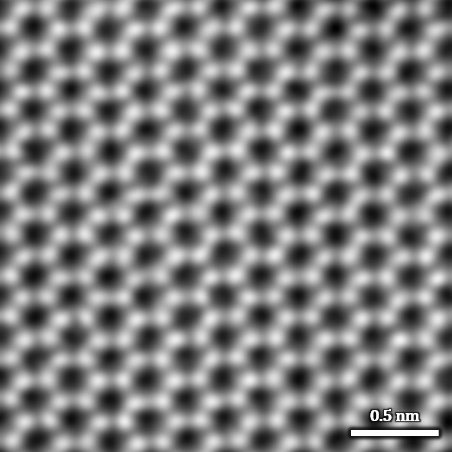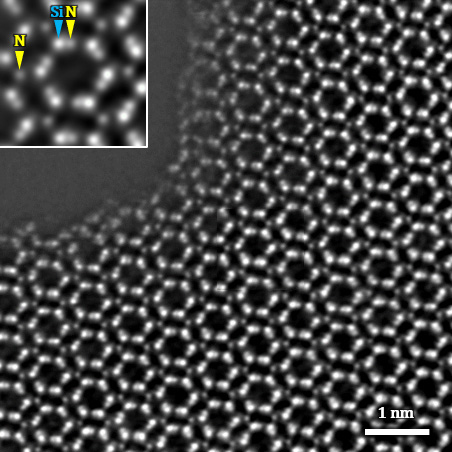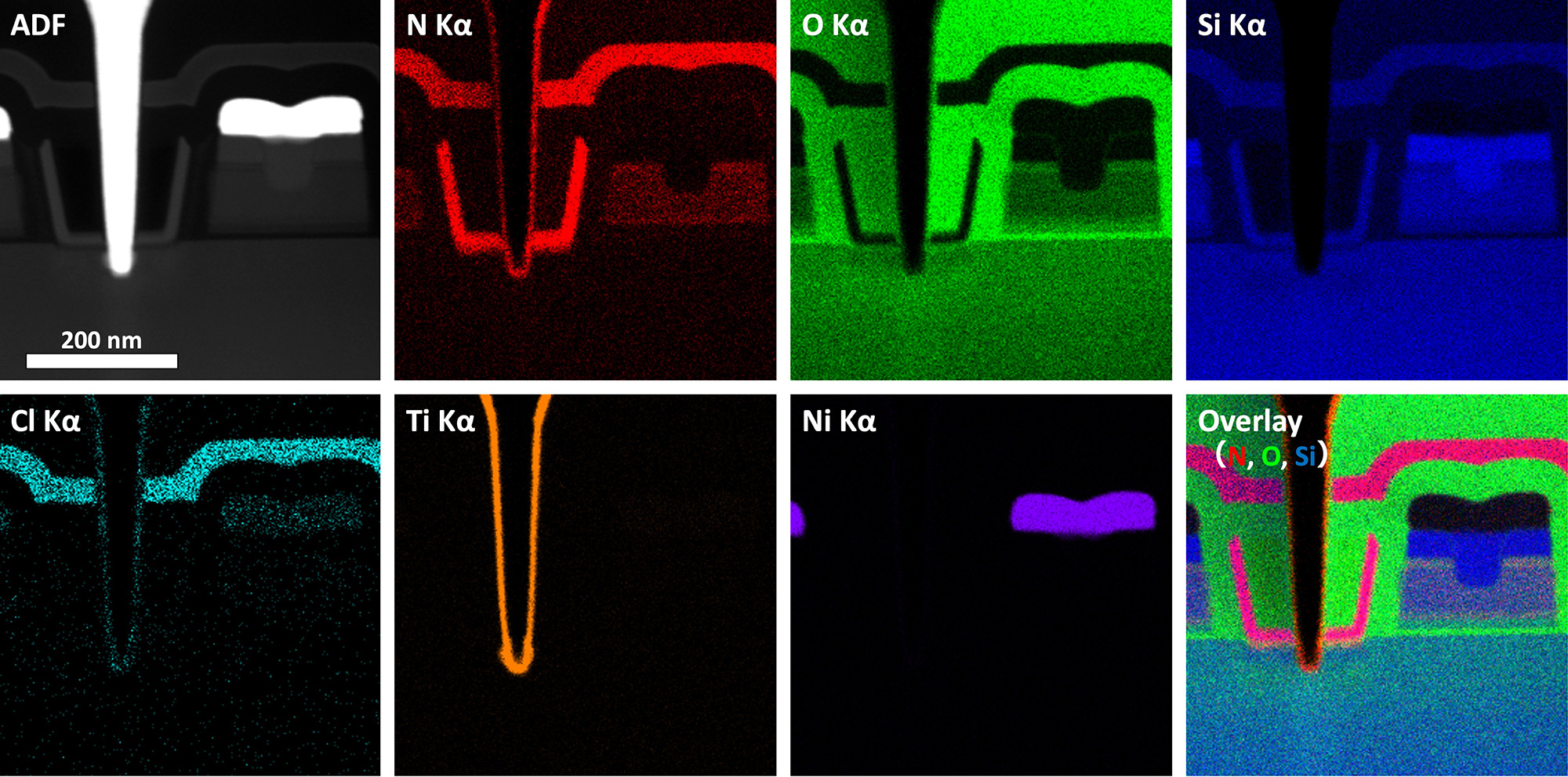JEM-ARM200F
NEOARM Atomic Resolution
Analytical Electron Microscope

"NEOARM" / JEM-ARM200F comes with JEOL’s unique cold field emission gun (Cold FEG) and a new Cs corrector (ASCOR) that compensates for higher order aberrations. The combination of a Cold FEG and ASCOR enables atomic-resolution imaging at not only 200 kV accelerating voltage, but also a low voltage of 30 kV.
"NEOARM" is also equipped with an automated aberration correction system that incorporates JEOL’s new aberration correction algorithm for automatic fast and precise aberration correction. This system enables higher-throughput atomic-resolution imaging.
Furthermore, a new STEM detector that provides enhanced contrast of light elements is incorporated as a standard unit. Contrast enhancement of light elements is achieved by a new STEM imaging technique (e-ABF: enhanced ABF), facilitating observation of light-element materials, even at low accelerating voltages.
The microscope room is separated from the operation room to respond to a remote operation. In addition, JEOL products’ new concept colors of "pure white" and "JEOL silver" are adopted, leading to a sophisticated exterior design of "NEOARM".
Features

Feature 1
Spherical aberration (Cs) corrector ASCOR (Advanced STEM corrector)
ASCOR incorporated in "NEOARM" can suppress the six-fold astigmatism which limits resolution after Cs correction.
The combination of ASCOR and Cold FEG gives low chromatic aberration and expands the diffraction limit, achieving higher resolution than ever.
GaN [211]:200 kV

Si [110]:80 kV

Graphene (mono layer):30 kV

STEM image by UHR cofiguration
Atomic resolution ADF-STEM images, their FFT patterns and Ronchigram images, obtained at 200kV, 80kV and 30kV
Feature 2
Automatic aberration correction software JEOL COSMO™ (Corrector System Module)
JEOL COSMO™ adopts a new aberration correction algorithm (SRAM: Segmented Ronchigram Auto-correlation function Matrix). Thus, no special sample is required for aberration correction, leading to high-precision and quick correction of higher order aberrations. This system enables fast processing compared to the conventional correction algorithm and also automates the operations, thus eliminating a complicated correction workflow in the customer microscope. These features enable higher-throughput atomic-resolution imaging.


Sample: Si[110]
Accelerating voltage: 200 kV
Feature 3
New ABF (Annular Bright Field) detector system
The ABF detector is widely used as a technique suitable for high-resolution imaging of light elements. "NEOARM" supports enhanced contrast of light elements by a newly-designed ABF imaging technique (e-ABF:enhanced ABF).
This capability facilitates atomic-level structure observation of materials containing light elements.

Reference: S.D. Findlay, Y.Kohno, L.A. Cardamone, Y.Ikuhara, N.Shibata, Ultramicroscopy 136 (2014)31-41.
Feature 4
Perfect sight detector
The perfect sight detector, integrated into "NEOARM", uses hybrid scintillators.
This detector always enables the acquisition of high-contrast and quantitative STEM images, irrespective of accelerating voltage settings.
Feature 5
OBF System (Option) *
In the new imaging method 'OBF STEM (Optimum Bright Field STEM)', raw images acquired by a segmented STEM detector are used as the source for a phase image reconstruction, with dedicated Fourier filters to maximize the signal to noise ratio of retrieved image.
This promising method realizes higher contrast for both heavy and light elements even while operating under extremely low electron dose conditions. Beam sensitive materials difficult to observe with standard ADF and ABF STEM methods can be easily analyzed with higher contrast at a wide range of magnifications.
K. Ooe, T. Seki, et al., Ultramicroscopy 220, 113133 (2021)
STEM Low Dose Imaging
The beam sensitive materials including Metal Organic Frameworks (MOFs) and Zeolites require a reduced electron dose (typically, probe current < 1.0 pA) while maintaining clear atomic contrasts for the framework of light elements.
The OBF STEM has an advantage for such low dose experiments, realizing ultra high dose-efficient STEM imaging in an atomic resolution.
Both of OBF STEM Image MOF MIL-101(left) and MFI Zeolite (right) are acquired in a single shot and the high spatial resolution of 1 Å can also be observed on the FFT pattern in right inset. Moreover, stack image averaging (left inset) confirms that resolution and contrast are very well balanced.

Sample : MOF MIL-101
Instrument : JEM-ARM300F2
Accelerating Voltage : 300 kV
Convergence Semi-angle : 7 mrad
Probe current : < 0.15 pA
Insets) FFT pattern and 50 frames averaged image
Sample courtesy of Prof. Zhenxia Zhao, Guangxi University

Sample : MFI Zeolite
Instrument : JEM-ARM300F2
Accelerating Voltage : 300 kV
Convergence Semi-angle : 16 mrad
Probe current : 0.5 pA
Insets) FFT pattern
High Contrast Imaging for Light Elements
In addition to being highly dose efficient, OBF STEM is also advantageous for light element imaging.
Even in a lower acceleration voltage, both higher contrast and spatial resolution can be achieved for light elements.

Sample : GaN [110]&amp;amp;amp;amp;amp;amp;amp;amp;amp;lt;br /&amp;amp;amp;amp;amp;amp;amp;amp;amp;gt;Instrument : JEM-ARM200F&amp;amp;amp;amp;amp;amp;amp;amp;amp;lt;br /&amp;amp;amp;amp;amp;amp;amp;amp;amp;gt;Accelerating Voltage : 60 kV&amp;amp;amp;amp;amp;amp;amp;amp;amp;lt;br /&amp;amp;amp;amp;amp;amp;amp;amp;amp;gt;Convergence Semi-angle : 35 mrad

Sample : Graphene
Instrument : JEM-ARM200F
Accelerating Voltage : 60 kV
Convergence Semi-angle : 35 mrad
The resolution for light elements becomes much better with a higher acceleration voltage.
Each atomic column is now clearly separated with a deep sub-angstrom resolution inside complex structures or along higher-index crystallographic axes.
The quality of OBF STEM is excellent in low dose conditions, and further enhanced under the standard probe conditions of a Cs-corrected electron microscope.

Sample : β-Si3N4 [0001]
Instrument : JEM-ARM200F
Accelerating Voltage : 200 kV
Convergence Semi-angle : 24 mrad
Inset) 10 frames averaged

Sample : GaN [211]
Instrument : JEM-ARM300F2
Accelerating Voltage : 300 kV
Convergence Semi-angle : 32 mrad
Inset) 20 frames averaged
e-ABF (enhanced ABF) is not available in SAAF Quad configuration.
Live OBF Imaging
In an actual experiment, live OBF imaging is fundamental for beam sensitive materials as all operations should be performed in a dose limited condition. The live function is included in the OBF system, implemented within the TEM control software, with simple GUI control and real time display updates alongside conventional STEM images.
Movie
Live observation of OBF-STEM images with JEM-ARM200F
◆Click the "replay" button in the box above, and the movie will start (about 1 min.)◆
Specifications
| Resolution※1 | STEM HAADF image 70 pm (200 kV), 100 pm (80 kV), 160 pm (30 kV) TEM information limit 100 pm (200 kV), 110 pm (80 kV), 250 pm (30 kV) |
|---|---|
| Electron gun | Cold field emission gun (Cold FEG): standard |
| Aberration corrector | STEM: NEO ASCOR HOAC※2, TEM: CETCOR with DSS※3 |
| Corrector auto tuning system | NEO JEOL COSMO™ Auto tuning system Ad-hock tune (SIAM) built-in |
| Accelerating voltage | 30 to 200 kV (80, 200 kV : standard, 30, 60, 120 kV : optional) |
| Magnetic field free mode | Lorentz lens settings (×50 to 80 k on screen): standard |
| Specimen movement system | X, Y and Z super-fine mechanical drive, ultra-fine piezo device drives: standard |
| Operation type | RDS※4 operation |
UHR (UHR with STEM/TEM Cs corrector configured)
HOAC (Higher order aberration corrector)
DSS (DeScan system)
RDS (Room divided style)
Catalogue Download
JEM-ARM200F NEOARM Atomic Resolution Analytical Electron Microscope
Application
Application JEM-ARM200F_NEOARM
Gallery
EDS Gallery
Strontium Titanate (high-resolution)

| Sample | Strontium Titanate |
|---|---|
| Acc. voltage | 200 kV |
| Map size | 1024×1024 pixel |
Semiconductor Devices

| Sample | Semiconductor Devices |
|---|---|
| Acc. voltage | 200 kV |
| Map size | 256×256 pixel |
Gallium Nitride@60 kV

| Sample | Gallium Nitride |
|---|---|
| Acc. voltage | 60 kV |
| Probe current | 34.5 pA |
| Map size | 256×256 pixel |
Related Products

SightSKY™ Series High-Sensitivity, Low-Noise Fiber-Coupling CMOS Camera
High-sensitivity, low-noise 19 M pixel CMOS sensor enables imaging of fine specimen detail and obtains high signal to noise images even at low electron doses.A Global shutter and high frame rate (58 fps/full pixel mode) enable image series acquisitions with less artifacts during in-situ dynamic observation studies.The SightSKY™ camera system offers integration with JEOL’s FEMTUS™ Integrated Analysis Platform, providing user-friendly operation and data acquisition.
More Info
Are you a medical professional or personnel engaged in medical care?
No
Please be reminded that these pages are not intended to provide the general public with information about the products.

